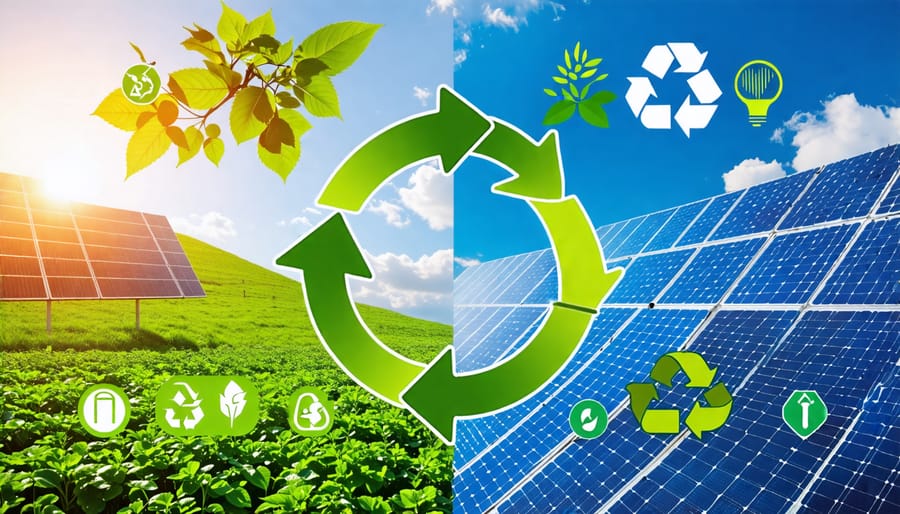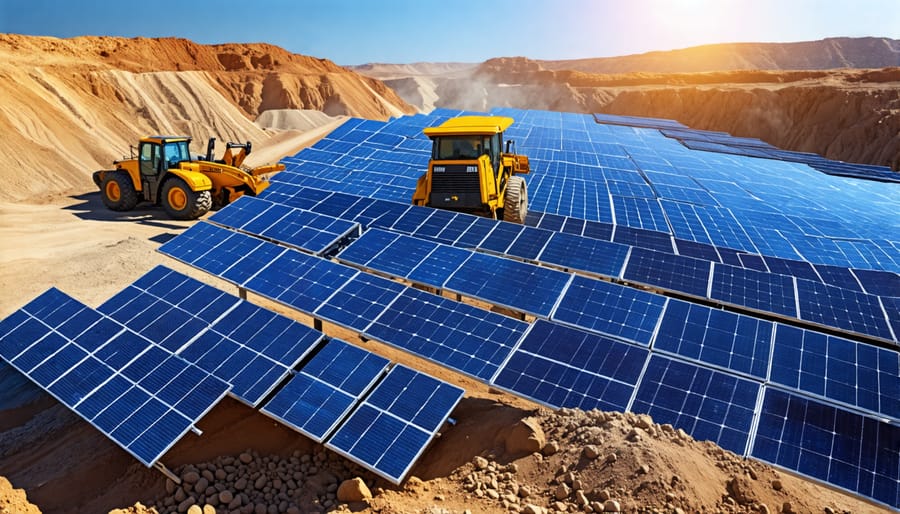How Solar Panels Transform from Raw Materials to Sustainable Energy Powerhouses

Explore the lifecycle of solar panels by sourcing sustainably mined raw materials to minimize environmental impact. Implement innovative and efficient manufacturing processes emphasizing durability and energy efficiency. Install panels professionally, ensuring optimal positioning and connection for maximum performance in varied European climates. Monitor and maintain systems regularly to extend operational life and efficiency. Finally, when panels reach the end of their life, prioritize recycling, leveraging Europe’s advanced recycling facilities to reclaim valuable materials, reduce waste, and support a circular economy.
Raw Material Acquisition and Mining
Crucial Materials: Silicon and Metals
Silicon, copper, and silver are essential materials in the construction of solar panels, driving innovation and sustainability in the field of renewable energy. Silicon, derived from abundant silica, forms the core of photovoltaic cells due to its semiconducting properties, essential for converting sunlight into electricity efficiently. The European solar industry is at the forefront of developing cost-effective methods to source and refine this crucial element, enhancing the sustainability of their solar solutions.
Copper plays a pivotal role in solar panels’ electrical performance, being primarily used for wiring and connections because of its superior conductivity. Europe’s commitment to sustainability ensures that copper is often sourced from recycled materials, reducing environmental impact and supporting circular economies.
Silver, though used sparingly, is vital for its role in improving the electrical current flow within the panel. European manufacturers are innovating to minimize silver usage, balancing performance with resource conservation. Together, these materials are integral to the lifecycle of solar panels, underpinning efforts towards a sustainable and efficient energy future.
Sustainable Mining Initiatives
In recent years, sustainable mining initiatives have become pivotal in reducing the environmental impact associated with extracting materials for solar panels. European efforts are at the forefront, employing cutting-edge technologies and innovative approaches to ensure that resource mining aligns with ecological conservation. Key strategies include the adoption of closed-loop water systems that drastically reduce water wastage during extraction processes and the use of electric and hybrid vehicles in mining operations to cut down on carbon emissions. Moreover, many mining companies are investing in reforestation projects and land reclamation, which help restore natural habitats once mining activities conclude. Commitment to these sustainable practices is evident in the rigorous environmental assessments and continuous monitoring efforts that aim to minimize the impact on local ecosystems. This holistic approach not only supports the growing demand for solar energy but also ensures that European industries lead in promoting environmental efficiency and responsibility throughout the entire lifecycle of solar panels.

Manufacturing Process
From Ingot to Wafer
The journey from ingot to wafer is a fascinating part of the solar panel lifecycle, showcasing both technical precision and innovative solutions. It begins with silicon, harvested primarily in Europe due to its abundant natural reserves and advanced processing capabilities. These raw silicon materials undergo purification and are melted down into ingots—cylindrical blocks where the atoms are aligned to ensure optimal sunlight absorption.
Using precision cutting techniques like wire sawing, these ingots are then sliced into thin wafers. Each wafer is meticulously crafted to maximize efficiency, balancing durability with the need to harness the maximum amount of solar energy. During this process, European industries prioritize sustainability, implementing cutting-edge technologies to minimize waste and enhance energy efficiency.
By meticulously transforming silicon ingots into wafers, the solar industry underscores its commitment to ecological responsibility and energy innovation. This essential step not only influences the efficiency of the final solar panels but also reinforces Europe’s role in leading sustainable energy solutions, providing comprehensive support to homeowners and businesses alike.

Cell Creation and Assembly
Creating solar cells and assembling them into panels is a sophisticated process that begins with essential core components like silicon wafers. These wafers are meticulously engineered from high-quality silicon, a material prized for its efficiency in converting sunlight to electricity. The wafers undergo a series of treatments, including doping, which introduces elements to create the electrical properties necessary for power generation. This innovation in treatment optimizes efficiency.
Next, the solar cells are coated to protect them from environmental damage while enhancing their energy absorption capabilities. Once ready, these cells are interconnected by thin metal strips, allowing for efficient power flow. In the assembly stage, multiple solar cells are arranged into a grid-like structure, forming a solar panel. This assembly is then encased in durable materials, ensuring resistance to the European climate, while maintaining aesthetics that complement residential and industrial settings. Every step is guided by a commitment to sustainability, supporting Europe’s transition to renewable energy solutions.
Quality Control and Testing
Solar panels undergo a series of rigorous quality control and testing procedures to ensure they meet high standards of efficiency and durability. These evaluations include thermal cycling, humidity-freeze, and mechanical load testing, which simulate extreme weather conditions, prevalent across Europe. By exposing panels to such stresses, manufacturers can ensure they remain functional and reliable over their 25-year average lifespan. In addition to environmental testing, electroluminescence tests are conducted to detect microcracks and defects not visible to the naked eye. These thorough processes underscore the innovative and sustainable nature of solar technology, offering European homeowners and businesses robust renewable energy solutions.
Distribution and Installation
Logistics and European Distribution Network
In Europe, the distribution network for solar panels is a sophisticated system designed to enhance efficiency, sustainability, and impact. Solar panels journey from manufacturing hubs to residential rooftops or large-scale industrial installations through a robust network of logistics providers. Emphasizing sustainability, these logistics practices include the use of energy-efficient transportation and the optimization of routes to reduce carbon emissions. Partnerships with local distributors ensure that installation and maintenance services meet the highest standards. This cohesive network not only accelerates project completion times but also supports European homeowners and businesses in adopting solar innovations conveniently and reliably, fostering a greener future.
Installation Procedures
The installation of solar panels in Europe involves meticulous planning and customization to accommodate diverse climatic conditions across the continent. Professional installers begin by conducting a site assessment to determine optimal panel placement, taking into account factors such as roof orientation, angle, and shading to maximize sunlight exposure. The process involves securely mounting panels on rooftops or specialized ground structures, ensuring they can withstand regional weather patterns—from the snowy peaks of the Alps to the sunny plains of Southern Spain. Installations incorporate advanced technologies, like microinverters, to enhance energy efficiency and address variations in solar panel output due to changing daylight conditions. Installers provide comprehensive support, guiding homeowners, businesses, and industries through each phase, ensuring systems are grid-compliant and efficiently integrated into existing energy setups. This attention to detail ensures not only robust performance but also promotes sustainability and energy innovation across Europe, reinforcing the continent’s commitment to reducing carbon footprints and embracing renewable energy solutions.
Performance and Longevity
Factors Influencing Efficiency
Efficiency in solar panels is influenced by a variety of environmental and technological factors. In Europe, where diverse climates range from sunny Mediterranean to cloudy northern regions, the amount of sunlight exposure directly impacts energy output. Technologically, innovation in photovoltaic (PV) cell materials plays a critical role. Advances such as bifacial panels, which absorb sunlight from both sides, and perovskite cells, known for their impressive power conversion capabilities, are driving efficiency improvements. Moreover, the integration of smart technology, which allows panels to adapt to shading and varying light conditions, enhances performance.
Sustainability is another significant factor; the European Union’s commitment to reducing carbon emissions encourages the use of recycled materials in solar panel production, promoting efficiency and eco-friendliness. Additionally, comprehensive support throughout the project’s lifecycle—from design to implementation—ensures that systems are optimized for maximum output. By understanding and leveraging these factors, European homeowners, businesses, and industries can effectively harness solar energy, contributing to a greener future.
Maintenance and Upkeep
Ensuring the optimal performance and longevity of your solar panels requires minimal yet essential maintenance. Routine cleaning is crucial, particularly in areas with low rainfall or high levels of dust and pollution, to prevent efficiency-reducing build-up. Depending on the environmental conditions, panels might need cleaning biannually with a soft cloth or sponge and gentle soap. Additionally, regular inspections by a professional can ensure that panels are free from physical damage and that all connections are secure. This proactive approach not only safeguards your investment but also aligns with broader sustainability goals by maximizing the energy output of your system.
Monitoring systems can provide real-time updates and alerts, making it easier to detect and address any issues promptly. Integrating these practices, as outlined in our comprehensive solar panel maintenance guide, can significantly enhance the return on investment for European homeowners, businesses, and industries. Prioritizing panel maintenance is a step towards innovation and sustainability—key elements in a robust solar energy solution life cycle.
Lifecycle Conclusion and Recycling
At the end of their lifecycle, solar panels emerge as candidates for a transformative journey that embodies the essence of innovation and sustainability. With Europe at the forefront of environmental initiatives, solar panel recycling offers a promising solution to a growing concern. Panels, after decades of efficient service, don’t simply fade into obsolescence; instead, they contribute to a circular economy by ensuring the valuable materials within are reclaimed and reused.
Typically, solar panels comprise glass, aluminum, and silicon, components that can be repurposed with expert efficiency. Recycling facilities across Europe are developing cutting-edge processes to extract these materials. For instance, broken glass is crushed and reused, while aluminum frames are smelted to create new components, reducing the demand for fresh resources. Meanwhile, the silicon within the cells is meticulously recovered and purified, ready to power new solar modules.
This robust recycling framework not only minimizes environmental impact but also aids in reducing overall production costs for new panels, facilitating broader access to solar technology. As European homeowners, businesses, and industries invest in solar energy, comprehensive support projects help manage the entire lifecycle, from installation to end-of-life disposal.
Ultimately, the conclusion of a solar panel’s lifecycle marks not an end, but a transition into new potential. By embracing recycling, we propel forward on the path to sustainability, ensuring that our green energy solutions complement the natural harmony we seek to preserve. Through these practices, Europe is setting an inspiring precedent for global energy strategies.

Conclusion
In conclusion, the lifecycle of solar panels plays a pivotal role in advancing sustainable energy across Europe. From the initial sourcing of raw materials to the manufacturing, installation, and operation phases, solar panels demonstrate a commitment to environmental responsibility. As they reach the end of their use, innovative recycling processes ensure that their components are repurposed, minimizing waste and contributing to a circular economy. The adoption of solar panels provides European homeowners, businesses, and industries with a reliable and efficient energy solution that significantly reduces carbon footprints. With the European Union’s strong emphasis on sustainability and innovation, solar energy projects receive comprehensive support, making the transition smoother and more accessible for various stakeholders. By considering solar panel solutions, you join a growing community dedicated to building a cleaner, greener future. Embracing solar energy not only empowers individual energy independence but also drives positive change on a continental scale, reaffirming Europe’s leadership in renewable energy innovation and sustainability.
Leave a Reply